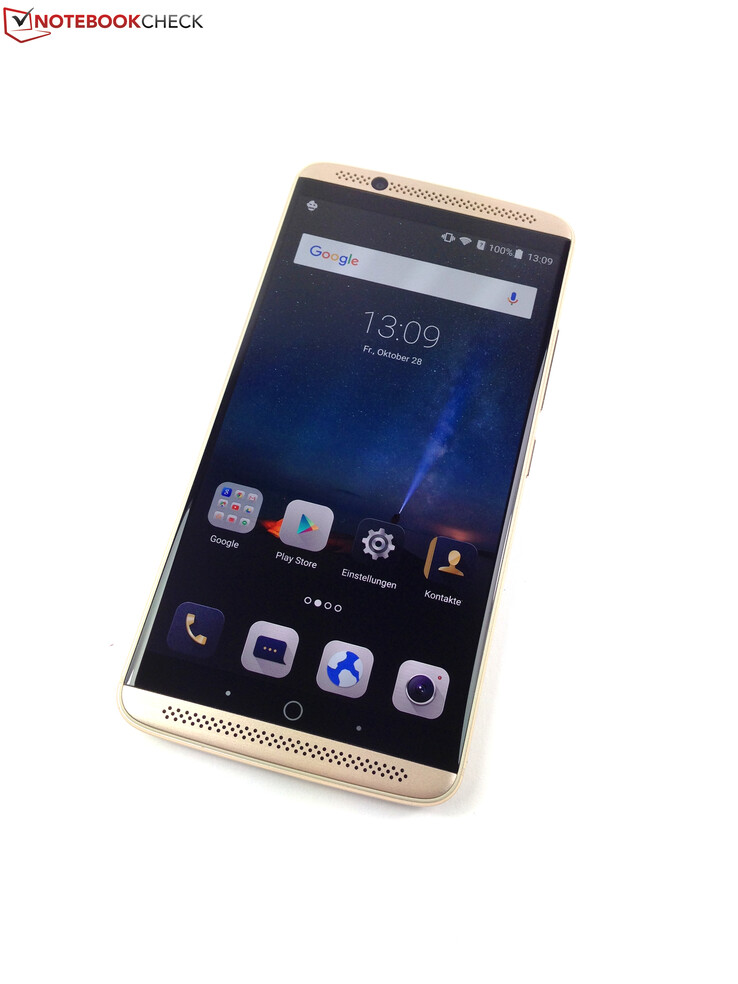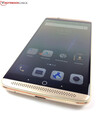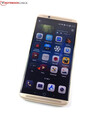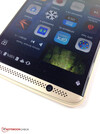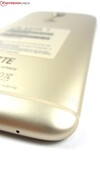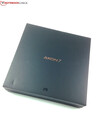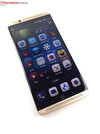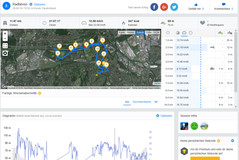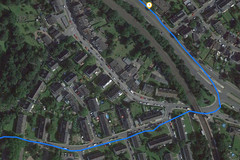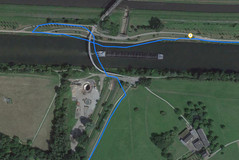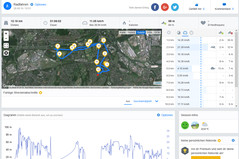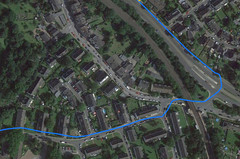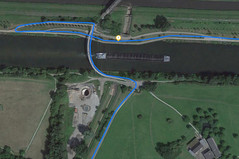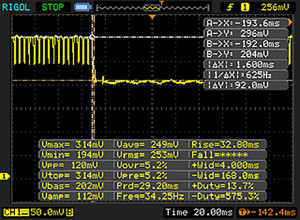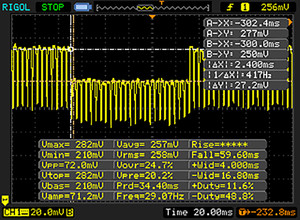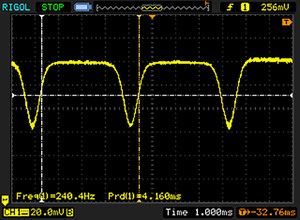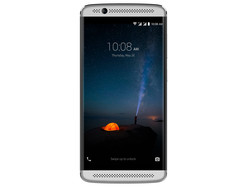Breve análisis del Smartphone ZTE Axon 7
Top 10 Análisis
» Top 10 Portátiles Multimedia
» Top 10 Portátiles de Juego
» Top 10 Portátiles de Juego ligeros
» Top 10 Portátiles Asequibles de Oficina/Empresa
» Top 10 Portátiles de Juego Ligeros
» Top 10 Portátiles de Oficina/Empresa Premium
» Top 10 Estaciones de Trabajo
» Top 10 Subportátiles
» Top 10 Ultrabooks
» Top 10 Convertibles
» Top 10 Tablets
» Top 10 Tablets Windows
» Top 10 Tablets de menos de 250 Euros
» Top 10 Phablets (>5.5")
» Top 10 Smartphones
» Top 10 Smartphones (≤5")
» Top 10 Smartphones de menos de 300 Euros
» Top 10 Smartphones de menos de 120 Euros
» Top 10 Portátiles de menos de 1000 Euros
» Top 10 Portátiles de menos de 500 Euros
» Top 10 Portátiles de menos de 300 Euros
» Los Mejores Displays de Portátiles Analizados por Notebookcheck
| Networking | |
| iperf3 transmit AX12 | |
| Samsung Galaxy S7 | |
| OnePlus 3 | |
| ZTE Axon 7 | |
| LG G5 | |
| Lenovo Moto Z Play | |
| Asus Zenfone 3 ZE552KL | |
| iperf3 receive AX12 | |
| ZTE Axon 7 | |
| OnePlus 3 | |
| Samsung Galaxy S7 | |
| LG G5 | |
| Lenovo Moto Z Play | |
| Asus Zenfone 3 ZE552KL | |
| |||||||||||||||||||||||||
iluminación: 88 %
Brillo con batería: 328 cd/m²
Contraste: ∞:1 (Negro: 0 cd/m²)
ΔE ColorChecker Calman: 4.6 | ∀{0.5-29.43 Ø4.78}
ΔE Greyscale Calman: 2.8 | ∀{0.09-98 Ø5}
Gamma: 2.29
CCT: 6612 K
| ZTE Axon 7 AMOLED, 2560x1440, 5.5" | Asus Zenfone 3 ZE552KL IPS, 1920x1080, 5.5" | OnePlus 3 Optic-AMOLED, 1920x1080, 5.5" | Lenovo Moto Z Play AMOLED, 1920x1080, 5.5" | Samsung Galaxy S7 SAMOLED, 2560x1440, 5.1" | LG G5 IPS Quantum, 2560x1440, 5.3" | HTC 10 Super LCD 5, 2560x1440, 5.2" | |
|---|---|---|---|---|---|---|---|
| Screen | 20% | 11% | 43% | 33% | 11% | 23% | |
| Brightness middle (cd/m²) | 328 | 658 101% | 419 28% | 509 55% | 350 7% | 784 139% | 445 36% |
| Brightness (cd/m²) | 334 | 633 90% | 431 29% | 511 53% | 351 5% | 774 132% | 434 30% |
| Brightness Distribution (%) | 88 | 93 6% | 84 -5% | 93 6% | 98 11% | 91 3% | 93 6% |
| Black Level * (cd/m²) | 0.66 | 0.43 | 0.36 | ||||
| Colorchecker dE 2000 * | 4.6 | 4.9 -7% | 4.1 11% | 2.2 52% | 2.04 56% | 6.5 -41% | 2.8 39% |
| Colorchecker dE 2000 max. * | 14.7 | 9.1 38% | 12 18% | 5.8 61% | 3.25 78% | 11.7 20% | 5.8 61% |
| Greyscale dE 2000 * | 2.8 | 5.8 -107% | 3.3 -18% | 2 29% | 1.63 42% | 8 -186% | 3.7 -32% |
| Gamma | 2.29 96% | 2.26 97% | 2.1 105% | 2.25 98% | 2.07 106% | 2.22 99% | 2.31 95% |
| CCT | 6612 98% | 7840 83% | 6550 99% | 6768 96% | 6391 102% | 8699 75% | 7164 91% |
| Contrast (:1) | 997 | 1823 | 1236 | ||||
| Color Space (Percent of AdobeRGB 1998) (%) | 89.38 | 86.86 | 68.08 | ||||
| Color Space (Percent of sRGB) (%) | 100 | 99.35 | 97.46 |
* ... más pequeño es mejor
Tiempos de respuesta del display
| ↔ Tiempo de respuesta de Negro a Blanco | ||
|---|---|---|
| 3.2 ms ... subida ↗ y bajada ↘ combinada | ↗ 1.6 ms subida | |
| ↘ 1.6 ms bajada | ||
| La pantalla mostró tiempos de respuesta muy rápidos en nuestros tests y debería ser adecuada para juegos frenéticos. En comparación, todos los dispositivos de prueba van de ##min### (mínimo) a 240 (máximo) ms. » 13 % de todos los dispositivos son mejores. Esto quiere decir que el tiempo de respuesta medido es mejor que la media (20.2 ms) de todos los dispositivos testados. | ||
| ↔ Tiempo de respuesta 50% Gris a 80% Gris | ||
| 4.8 ms ... subida ↗ y bajada ↘ combinada | ↗ 2.4 ms subida | |
| ↘ 2.4 ms bajada | ||
| La pantalla mostró tiempos de respuesta muy rápidos en nuestros tests y debería ser adecuada para juegos frenéticos. En comparación, todos los dispositivos de prueba van de ##min### (mínimo) a 636 (máximo) ms. » 15 % de todos los dispositivos son mejores. Esto quiere decir que el tiempo de respuesta medido es mejor que la media (31.6 ms) de todos los dispositivos testados. | ||
Parpadeo de Pantalla / PWM (Pulse-Width Modulation)
| Parpadeo de Pantalla / PWM detectado | 240.4 Hz | ≤ 100 % de brillo | |
La retroiluminación del display parpadea a 240.4 Hz (seguramente usa PWM - Pulse-Width Modulation) a un brillo del 100 % e inferior. Sobre este nivel de brillo no debería darse parpadeo / PWM. La frecuencia de 240.4 Hz es relativamente baja, por lo que la gente sensible debería ver parpadeos y padecer fatiga visual por la pantalla (usado al brillo indicado a continuación). Comparación: 53 % de todos los dispositivos testados no usaron PWM para atenuar el display. Si se usó, medimos una media de 8098 (mínimo: 5 - máxmo: 343500) Hz. | |||
| AnTuTu v6 - Total Score (ordenar por valor) | |
| ZTE Axon 7 | |
| Asus Zenfone 3 ZE552KL | |
| OnePlus 3 | |
| Lenovo Moto Z Play | |
| Samsung Galaxy S7 | |
| LG G5 | |
| HTC 10 | |
| Geekbench 3 | |
| 64 Bit Single-Core Score (ordenar por valor) | |
| OnePlus 3 | |
| Samsung Galaxy S7 | |
| LG G5 | |
| HTC 10 | |
| 64 Bit Multi-Core Score (ordenar por valor) | |
| OnePlus 3 | |
| Samsung Galaxy S7 | |
| LG G5 | |
| HTC 10 | |
| 3DMark | |
| 1280x720 offscreen Ice Storm Unlimited Score (ordenar por valor) | |
| ZTE Axon 7 | |
| Asus Zenfone 3 ZE552KL | |
| OnePlus 3 | |
| Lenovo Moto Z Play | |
| Samsung Galaxy S7 | |
| LG G5 | |
| HTC 10 | |
| 1280x720 offscreen Ice Storm Unlimited Graphics Score (ordenar por valor) | |
| ZTE Axon 7 | |
| Asus Zenfone 3 ZE552KL | |
| OnePlus 3 | |
| Lenovo Moto Z Play | |
| Samsung Galaxy S7 | |
| LG G5 | |
| HTC 10 | |
| 1280x720 offscreen Ice Storm Unlimited Physics (ordenar por valor) | |
| ZTE Axon 7 | |
| Asus Zenfone 3 ZE552KL | |
| OnePlus 3 | |
| Lenovo Moto Z Play | |
| Samsung Galaxy S7 | |
| LG G5 | |
| HTC 10 | |
| 2560x1440 Sling Shot OpenGL ES 3.0 (ordenar por valor) | |
| ZTE Axon 7 | |
| Asus Zenfone 3 ZE552KL | |
| OnePlus 3 | |
| Lenovo Moto Z Play | |
| Samsung Galaxy S7 | |
| LG G5 | |
| HTC 10 | |
| 2560x1440 Sling Shot OpenGL ES 3.0 Graphics (ordenar por valor) | |
| ZTE Axon 7 | |
| Asus Zenfone 3 ZE552KL | |
| OnePlus 3 | |
| Lenovo Moto Z Play | |
| Samsung Galaxy S7 | |
| LG G5 | |
| HTC 10 | |
| 2560x1440 Sling Shot OpenGL ES 3.0 Physics (ordenar por valor) | |
| ZTE Axon 7 | |
| Asus Zenfone 3 ZE552KL | |
| OnePlus 3 | |
| Lenovo Moto Z Play | |
| Samsung Galaxy S7 | |
| LG G5 | |
| HTC 10 | |
| GFXBench (DX / GLBenchmark) 2.7 | |
| T-Rex Onscreen (ordenar por valor) | |
| ZTE Axon 7 | |
| Asus Zenfone 3 ZE552KL | |
| OnePlus 3 | |
| Lenovo Moto Z Play | |
| Samsung Galaxy S7 | |
| LG G5 | |
| HTC 10 | |
| 1920x1080 T-Rex Offscreen (ordenar por valor) | |
| ZTE Axon 7 | |
| Asus Zenfone 3 ZE552KL | |
| OnePlus 3 | |
| Lenovo Moto Z Play | |
| Samsung Galaxy S7 | |
| LG G5 | |
| HTC 10 | |
| GFXBench 3.0 | |
| on screen Manhattan Onscreen OGL (ordenar por valor) | |
| ZTE Axon 7 | |
| Asus Zenfone 3 ZE552KL | |
| OnePlus 3 | |
| Lenovo Moto Z Play | |
| Samsung Galaxy S7 | |
| LG G5 | |
| HTC 10 | |
| 1920x1080 1080p Manhattan Offscreen (ordenar por valor) | |
| ZTE Axon 7 | |
| Asus Zenfone 3 ZE552KL | |
| OnePlus 3 | |
| Lenovo Moto Z Play | |
| Samsung Galaxy S7 | |
| LG G5 | |
| HTC 10 | |
| GFXBench 3.1 | |
| on screen Manhattan ES 3.1 Onscreen (ordenar por valor) | |
| ZTE Axon 7 | |
| Asus Zenfone 3 ZE552KL | |
| OnePlus 3 | |
| Lenovo Moto Z Play | |
| Samsung Galaxy S7 | |
| LG G5 | |
| HTC 10 | |
| 1920x1080 Manhattan ES 3.1 Offscreen (ordenar por valor) | |
| ZTE Axon 7 | |
| Asus Zenfone 3 ZE552KL | |
| OnePlus 3 | |
| Lenovo Moto Z Play | |
| Samsung Galaxy S7 | |
| LG G5 | |
| HTC 10 | |
| PCMark for Android - Work performance score (ordenar por valor) | |
| ZTE Axon 7 | |
| Asus Zenfone 3 ZE552KL | |
| OnePlus 3 | |
| Lenovo Moto Z Play | |
| Samsung Galaxy S7 | |
| LG G5 | |
| HTC 10 | |
| Octane V2 - Total Score (ordenar por valor) | |
| ZTE Axon 7 | |
| Asus Zenfone 3 ZE552KL | |
| OnePlus 3 | |
| Lenovo Moto Z Play | |
| Samsung Galaxy S7 | |
| LG G5 | |
| HTC 10 | |
| Mozilla Kraken 1.1 - Total (ordenar por valor) | |
| ZTE Axon 7 | |
| Asus Zenfone 3 ZE552KL | |
| OnePlus 3 | |
| Lenovo Moto Z Play | |
| Samsung Galaxy S7 | |
| LG G5 | |
| HTC 10 | |
| WebXPRT 2015 - Overall (ordenar por valor) | |
| ZTE Axon 7 | |
| Asus Zenfone 3 ZE552KL | |
| OnePlus 3 | |
| Lenovo Moto Z Play | |
| Samsung Galaxy S7 | |
| LG G5 | |
| HTC 10 | |
| JetStream 1.1 - Total Score (ordenar por valor) | |
| ZTE Axon 7 | |
| Asus Zenfone 3 ZE552KL | |
| OnePlus 3 | |
| Lenovo Moto Z Play | |
| Samsung Galaxy S7 | |
| LG G5 | |
| HTC 10 | |
* ... más pequeño es mejor
| ZTE Axon 7 | Huawei Honor 8 | Asus Zenfone 3 ZE552KL | OnePlus 3 | Lenovo Moto Z Play | Samsung Galaxy S7 | LG G5 | HTC 10 | |
|---|---|---|---|---|---|---|---|---|
| AndroBench 3-5 | -17% | 7% | 3% | -3% | -6% | -17% | ||
| Sequential Read 256KB SDCard (MB/s) | 78.4 | 79.2 1% | 74.6 -5% | 72.3 -8% | 78.5 0% | 83.3 6% | ||
| Sequential Write 256KB SDCard (MB/s) | 51.3 | 50.1 -2% | 50.6 -1% | 53.6 4% | 45.53 -11% | 65.4 27% | ||
| Sequential Read 256KB (MB/s) | 406.5 | 282 -31% | 408.7 1% | 254.8 -37% | 483.8 19% | 427.6 5% | 275.1 -32% | |
| Sequential Write 256KB (MB/s) | 150.9 | 188 25% | 153.3 2% | 73.1 -52% | 145.7 -3% | 141.3 -6% | 115.6 -23% | |
| Random Read 4KB (MB/s) | 121.1 | 74 -39% | 137.6 14% | 38.78 -68% | 85.9 -29% | 89.3 -26% | 29.92 -75% | |
| Random Write 4KB (MB/s) | 16.22 | 7.4 -54% | 18.23 12% | 45.58 181% | 16.01 -1% | 16.22 0% | 15.89 -2% |
| Asphalt 8: Airborne | |||
| Configuraciones | Valor | ||
| high | 29 fps | ||
| very low | 29 fps | ||
| Dead Trigger 2 | |||
| Configuraciones | Valor | ||
| high | 60 fps | ||
(+) La temperatura máxima en la parte superior es de 39.5 °C / 103 F, frente a la media de 35.2 °C / 95 F, que oscila entre 21.9 y 247 °C para la clase Smartphone.
(+) El fondo se calienta hasta un máximo de 37.4 °C / 99 F, frente a la media de 34 °C / 93 F
(+) En reposo, la temperatura media de la parte superior es de 30.7 °C / 87# F, frente a la media del dispositivo de 32.9 °C / 91 F.
ZTE Axon 7 análisis de audio
(+) | los altavoces pueden reproducir a un volumen relativamente alto (#87.1 dB)
Graves 100 - 315 Hz
(-) | casi sin bajos - de media 25.8% inferior a la mediana
(±) | la linealidad de los graves es media (12.3% delta a frecuencia anterior)
Medios 400 - 2000 Hz
(±) | medias más altas - de media 6% más altas que la mediana
(+) | los medios son lineales (4.6% delta a la frecuencia anterior)
Altos 2 - 16 kHz
(±) | máximos más altos - de media 7.7% más altos que la mediana
(±) | la linealidad de los máximos es media (7% delta a frecuencia anterior)
Total 100 - 16.000 Hz
(±) | la linealidad del sonido global es media (24.4% de diferencia con la mediana)
En comparación con la misma clase
» 58% de todos los dispositivos probados de esta clase eran mejores, 7% similares, 35% peores
» El mejor tuvo un delta de 11%, la media fue 35%, el peor fue ###max##%
En comparación con todos los dispositivos probados
» 73% de todos los dispositivos probados eran mejores, 6% similares, 21% peores
» El mejor tuvo un delta de 4%, la media fue 24%, el peor fue ###max##%
Samsung Galaxy S7 análisis de audio
(+) | los altavoces pueden reproducir a un volumen relativamente alto (#87.4 dB)
Graves 100 - 315 Hz
(-) | casi sin bajos - de media 25.2% inferior a la mediana
(±) | la linealidad de los graves es media (9.2% delta a frecuencia anterior)
Medios 400 - 2000 Hz
(+) | medios equilibrados - a sólo 4.1% de la mediana
(+) | los medios son lineales (5% delta a la frecuencia anterior)
Altos 2 - 16 kHz
(±) | máximos más altos - de media 6.6% más altos que la mediana
(+) | los máximos son lineales (6.3% delta a la frecuencia anterior)
Total 100 - 16.000 Hz
(±) | la linealidad del sonido global es media (20.9% de diferencia con la mediana)
En comparación con la misma clase
» 38% de todos los dispositivos probados de esta clase eran mejores, 8% similares, 54% peores
» El mejor tuvo un delta de 11%, la media fue 35%, el peor fue ###max##%
En comparación con todos los dispositivos probados
» 56% de todos los dispositivos probados eran mejores, 8% similares, 36% peores
» El mejor tuvo un delta de 4%, la media fue 24%, el peor fue ###max##%
LG G5 análisis de audio
(+) | los altavoces pueden reproducir a un volumen relativamente alto (#86.4 dB)
Graves 100 - 315 Hz
(-) | casi sin bajos - de media 28.3% inferior a la mediana
(±) | la linealidad de los graves es media (12.5% delta a frecuencia anterior)
Medios 400 - 2000 Hz
(+) | medios equilibrados - a sólo 3.6% de la mediana
(+) | los medios son lineales (4.3% delta a la frecuencia anterior)
Altos 2 - 16 kHz
(+) | máximos equilibrados - a sólo 3.8% de la mediana
(+) | los máximos son lineales (1.9% delta a la frecuencia anterior)
Total 100 - 16.000 Hz
(±) | la linealidad del sonido global es media (18.8% de diferencia con la mediana)
En comparación con la misma clase
» 22% de todos los dispositivos probados de esta clase eran mejores, 10% similares, 68% peores
» El mejor tuvo un delta de 11%, la media fue 35%, el peor fue ###max##%
En comparación con todos los dispositivos probados
» 42% de todos los dispositivos probados eran mejores, 8% similares, 50% peores
» El mejor tuvo un delta de 4%, la media fue 24%, el peor fue ###max##%
| Off / Standby | |
| Ocioso | |
| Carga |
|
Clave:
min: | |
| ZTE Axon 7 3250 mAh | Asus Zenfone 3 ZE552KL 3000 mAh | OnePlus 3 3000 mAh | Lenovo Moto Z Play 3510 mAh | Samsung Galaxy S7 3000 mAh | LG G5 2800 mAh | HTC 10 3000 mAh | |
|---|---|---|---|---|---|---|---|
| Power Consumption | -47% | -18% | 29% | -1% | -40% | -44% | |
| Idle Minimum * (Watt) | 0.64 | 0.83 -30% | 0.57 11% | 0.51 20% | 0.68 -6% | 0.55 14% | 0.68 -6% |
| Idle Average * (Watt) | 0.84 | 2.11 -151% | 1.24 -48% | 0.87 -4% | 1.02 -21% | 1.37 -63% | 1.49 -77% |
| Idle Maximum * (Watt) | 0.87 | 2.12 -144% | 1.36 -56% | 0.9 -3% | 1.14 -31% | 2.25 -159% | 1.91 -120% |
| Load Average * (Watt) | 6.02 | 3.41 43% | 5.92 2% | 1.69 72% | 4.73 21% | 6.24 -4% | 7.4 -23% |
| Load Maximum * (Watt) | 10.45 | 5.46 48% | 10.53 -1% | 4 62% | 7.16 31% | 9.12 13% | 9.71 7% |
* ... más pequeño es mejor
| ZTE Axon 7 3250 mAh | Asus Zenfone 3 ZE552KL 3000 mAh | OnePlus 3 3000 mAh | Lenovo Moto Z Play 3510 mAh | Samsung Galaxy S7 3000 mAh | LG G5 2800 mAh | HTC 10 3000 mAh | |
|---|---|---|---|---|---|---|---|
| Duración de Batería | 38% | 28% | 95% | 10% | -1% | -13% | |
| Reader / Idle (h) | 28.9 | 25 -13% | 22.3 -23% | 42.3 46% | 30.2 4% | 30.6 6% | 21.2 -27% |
| H.264 (h) | 11.7 | 15.1 29% | 14.1 21% | 19.8 69% | 14.9 27% | 10 -15% | 10.8 -8% |
| WiFi v1.3 (h) | 6.9 | 13.3 93% | 14 103% | 13.7 99% | 7.6 10% | 6.5 -6% | 6.9 0% |
| Load (h) | 4.1 | 5.9 44% | 4.5 10% | 10.9 166% | 4 -2% | 4.5 10% | 3.4 -17% |
Pro
Contra
ZTE no ha prometido demasiado: El Axon 7 fácimente iguala a smartphones de gama alta tales como el Samsung Galaxy S7 aún cuando no termina de superarlos. El smartphone ZTE no tiene las características para rematar - un puerto USB más rápido, más almacenamiento interno, y carga inalámbrica le habrían llevado a una valoración algo más alta. Sin embargo, esto no disminuye para nada el soberbio paquete de configuración y rendimiento que se lleva el usuario con el Axon 7.
El ZTE Axon 7 no sólo es un digno oponente para smartphones de gama alta tales como el Samsung Galaxy S7, también convence con un sobresaliente sonido Dolby Surround.
Nos gustó particularmente la carcasa de gran calidad, el nítido panel QHD. la buenísima cámara, y el rendimiento más que suficiente para cada situación en el test. Y quien quiera busque un smartphone con un sonido realmente bueno sencillamente tendrá que llevarse el ZTE Axon 7 ya que acústicamente deja atrás a sus rivales a kilómetros con su sonido Dolby-Atmos.
El ZTE Axon 7 también tiene que aceptar algunas críticas, aunque no hay mucho que reprochar. Algunos usuarios quizá no queden contentos con el aspecto de la interfaz de usuario MiFavor 4.0 - pero el aspecto se puede cambiar para que parezca casi Android estándar con una app. Un puerto USB más rápido habría quedado bien en el Axon 7, así como un mejor aguante de batería y una batería extraible.
Ésta es una versión acortada del análisis original. Puedes leer el análisis completo en inglés aquí.
ZTE Axon 7
- 10/31/2016 v5.1 (old)
Manuel Masiero




